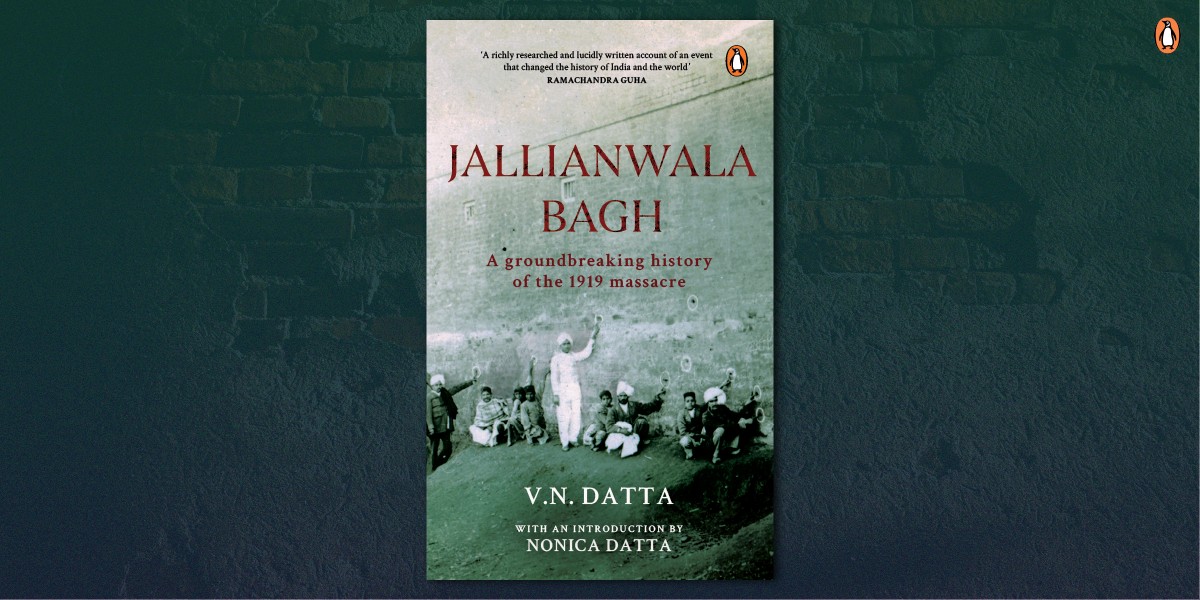V.N. Datta’s book remains relevant and immediate to this day. While his research documents the events of the Jallianwala Bagh massacre, its history, context and aftermath, it also reveals the failure of larger institutions of power and control. Here is an excerpt from the introduction to the 2021 edition:
In April 2019, 100 years after the massacre, the nation remembered Jallianwala Bagh as a major historical event in the long tale of Indian nationalism and independence. Jallianwala Bagh has become an integral part of the grand saga of the nation’s history. Yet, not all local memories match the prevailing narrative; and here Datta’s book reminds us not to be swayed by the nationalist frenzy.
As preparations were underway for the centenary commemoration, I walked into Jallianwala Bagh intending to unearth its hidden histories. I met a Sikh policeman at the gate who led me to the narrow ‘Historical Lane’ to the Bagh. He told me that Dyer had brought guns and troops through this constricted passage to shoot at the innocent crowd that had assembled in the Bagh on 13 April, the day of the Baisakhi mela, which is celebrated with much fanfare in Punjab. ‘There were no exit points,’ he says. ‘People in panic ran to the walls to escape. They jumped into the khoo [well].’
While in the Bagh, I was taken over by mixed feelings. It looked like an insignificant garden with some old trees abutting the residential buildings at the back. However, there was something eerie about the place. The very ordinariness of the site was almost shocking in view of the violence that occurred there. Of course, there are commemorative structures that are not ordinary. To the right is the amar jyoti, the eternal flame. The pedestal is inscribed with the words Vande Mataram, praise to the motherland. There is also an old samadhi with a dome. At the centre of the Bagh stands an impressive oblong-shaped cenotaph. And to its right is the deadly khoo. Further down is the passage to the Martyrs’ Gallery and a museum. The bullet-ridden wall represents the horror that occurred here. The gaping marks are a tragic testimony to Dyer’s savagery in the Bagh. They are all too visible. The plaque says,
The wall has its own historic significance as it has thirty-six bullet marks which can be easily seen at present and these were fired into the crowd by the order of General Dyer. Moreover, no warning was given to disperse before Dyer opened fire which [sic] was gathered here against the Rowlatt Act. One Thousand Six Hundred and Fifty Rounds were fired.
…The Bagh shapes a national memory and constructs a national past through a patchwork of myth and history, fact and fiction. As Madan Lal Vij, the city’s historian, told me, ‘After the kand [scandalous episode], Jallianwala Bagh became a historic garden and a national memorial.’ The city’s local tragedy is fashioned as a national crisis through the idea of shahadat, martyrdom. A white flame-like sculpture stands with faces of martyrs and all their names engraved below. The compound surrounding Jallianwala Bagh is today part of a larger heritage area that includes the Golden Temple and the old Town Hall. The Congress narrative, as shown on the plaque, forges a direct connection between the massacre and the Rowlatt Act.

The construction of a definitive history in Jallianwala Bagh obfuscates the complex truths of the massacre, which contain unresolved contradictions and ambiguities. One such ambiguity is the nationalist attempt to establish an unmediated relationship between the crowd in the Bagh and the anti-Rowlatt Act protests. However, the irony is that to present the crowd as agitators alone would authenticate the claims of Dyer and official histories and do an injustice to the plural memories and differentiated experiences of the victims. I asked the locals to share their memories. ‘It was a random crowd, some were playing cards, others had come to celebrate the Baisakhi mela,’ says the octogenarian Om Prakash Seth from Katra Ahluwalia. ‘It was not a political meeting,’ adds Trilok Chand, one of the oldest booksellers at Hall Bazaar. Udham Singh’s history in the Bagh presents yet another dilemma. It is doubtful whether he was ever present in the Bagh at the time of the massacre. Doubtless, Jallianwala Bagh is primarily dominated by the story of Gandhi’s satyagraha and Udham Singh’s martyrdom.
The tailored history of the Bagh tends to ignore the diverse echoes and voices. We know little about the people who were in the Bagh and what they were up to. Popular memories too are shifting. Dyer’s shooting is no longer central to their recollections. People feel excluded from the mainstream history of Jallianwala Bagh. The locals see themselves as victims of a state that has let them down consistently since 1919.
…My journey to Amritsar tracing the memories of Jallianwala Bagh was greatly enriched by Datta’s insights and revelations. Even after the 100th year of commemoration, his work becomes all the more immediate. As a historian writing in the 1960s, his crafting of an intricate narrative and analysis of 1919, uncomfortably entangled with local and national histories, is no mean feat. Recognized as a classic across the global community of scholars, V.N. Datta’s Jallianwala Bagh deserves a wider readership for generations to come.
Some books never cease to remain relevant. Jallianwala Bagh is one such.







